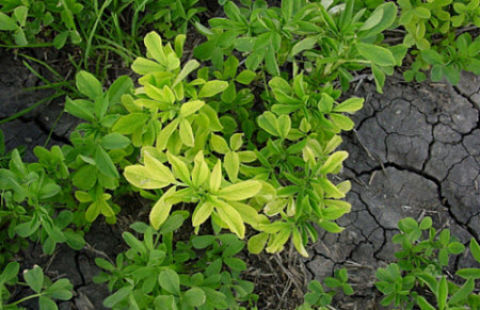Boron is not part of a normal soil test; in fact, it’s not part of an expanded soil test. Logically then, most farmers have no idea how much boron is in their soil, or even that’s a nutrient of any concern.
Boron is vital for a plant’s cell wall and can affect many plant processes. Boron is necessary for canola and cotton production and important for other dicots like alfalfa and soybeans. High production crops like corn and milo have a need for boron as well. Southeast Kansas and eastern Missouri do not have a natural background of high boron.
Boron has not been well studied in Kansas. It is hard to say just how much boron is needed in the soil for high-yielding crops and it seems that different state extensions have different target ranges. Not to mention that research has a hard time showing yield response to corn and soybean boron fertilization; however, soybeans are very sensitive to boron toxicity. Yield response to alfalfa has been easier to find. Boron is vital for crops, yet they only need a small amount, and too much is toxic. You can see why recommendations for boron are hard to pin down.
Boron in the soil
To understand how to fertilize with boron, it is important to know how it works in the soil. First, boron is uniquely a non-ionic molecule (boric acid) in the soil and can move freely in the soil. Fortunately, it still adsorbs onto aluminum and iron oxides, clays minerals, and organic matter. Most plant available boron comes from the breakdown of organic matter. Oddly, soils in southeast Kansas are deficient in boron yet have relatively high organic matter and clay content. Many areas across the country with high amounts of leeching are boron deficient. Because boron moves with water and largely comes from decomposition, drought can decrease availability of boron to plants.
Fertilization of boron
Fertilization of boron is mainly a concern of alfalfa, to a lesser degree in soybeans, and to some limited extent in corn. It is also more important in canola and cotton, if these less common crops are grown.
Research from Minnesota and Nebraska has shown that alfalfa has a better yield response to boron fertilization then a number of other crops. This is likely because of its cool season growth before organic matter breakdown has started to supply boron and certain other plant growth reasons. In soybeans, research is all over the place.
A study in Nebraska shows that boron only helped yields in sandy soils. In Missouri, very little yield response, but in Arkansas, boron increased soybean yields in three of the four tested locations. Kansas research has also shown variable response to boron. In corn, some research has found positive yield benefits but most show little response.
Putting it all together, these boron fertilizer recommendations are agreed upon:
• Fields below 0.5 to 1.0 ppm of boron are deficient.
• Application rates are, at maximum, 2 lbs. boron per acre. Most research shows 1 lb. boron per acre is plenty. Any more than 2 pounds and boron could become toxic.
• Boron is not to be banded. Do not plant any grass crops (e.g., corn, milo, fescue) immediately after a boron application. Incorporation after application is best but can work in no-till.
• A 1- to 2-pound application rate will be plenty in our clay soils for a number of years and it should only be reapplied in future years after a soil test.
Boron fertilizer comes in both liquid and granular. Granular is easiest to get a hold of and is best mixed with DAP or potash for a more even application. The dry boron fertilizer might actually be borax—the same product people use to clean clothes or kill ants.
Deficiency symptoms
Visually boron deficient soybeans are rare. It is more likely to occur in sandy and low organic matter soils and in drought years. Deficient soybeans will have yellow, leathery, and cupped leaves on the new growth and growing points will be stunted or dead. There can however be hidden minor deficiencies. The symptoms in alfalfa are stunted yellow newer leaves, and the terminal buds can be discolored or dead. While more likely in alfalfa, in any crop, visual boron deficiency is unlikely and looks like a number of other nutrient issues.
Sign up for HPJ Insights
Our weekly newsletter delivers the latest news straight to your inbox including breaking news, our exclusive columns and much more.
We know that boron is important for crop growth and we know that many soils are deficient in this nutrient. However, yield response in some crops is unlikely, but could be a benefit in alfalfa and possibly soybeans. In any case, a pound or two of boron per acre is going to be a pretty cheap fertilizer in comparison, as long as care is taken in its application.
For more information, contact James Coover, crop production agent, [email protected] or 620-724-8233.




